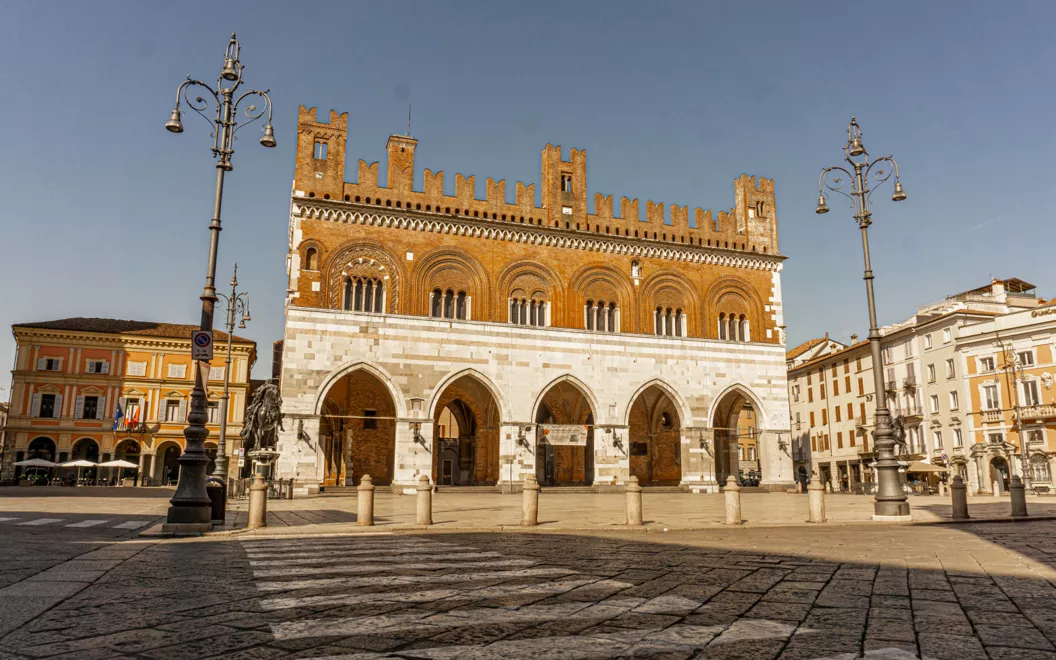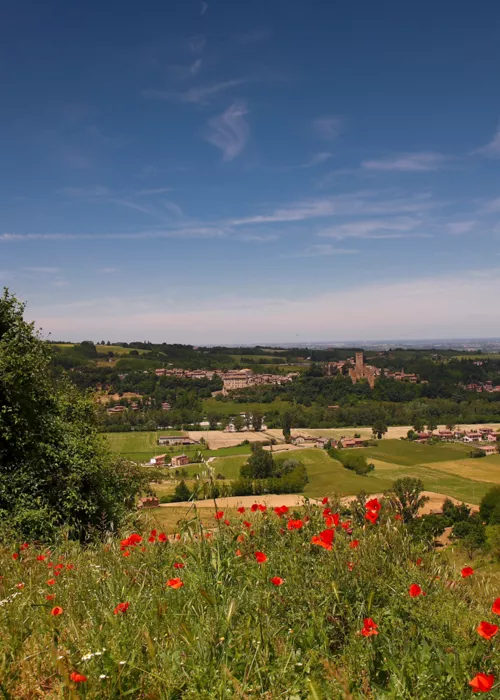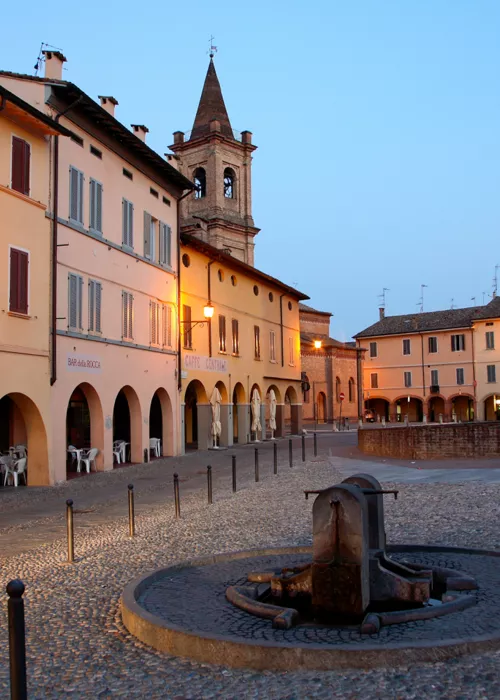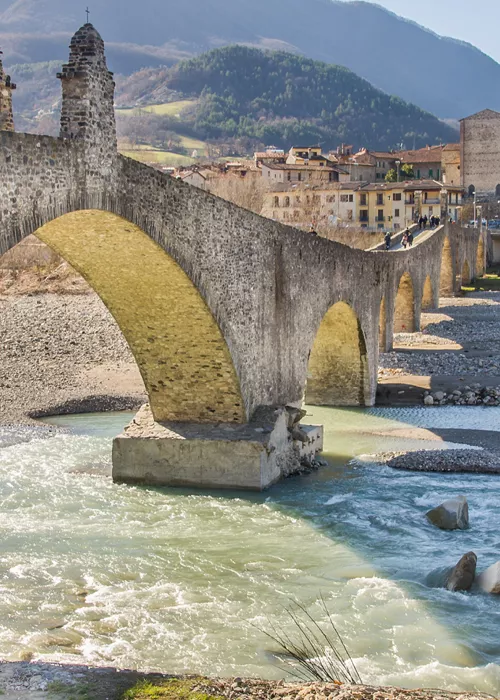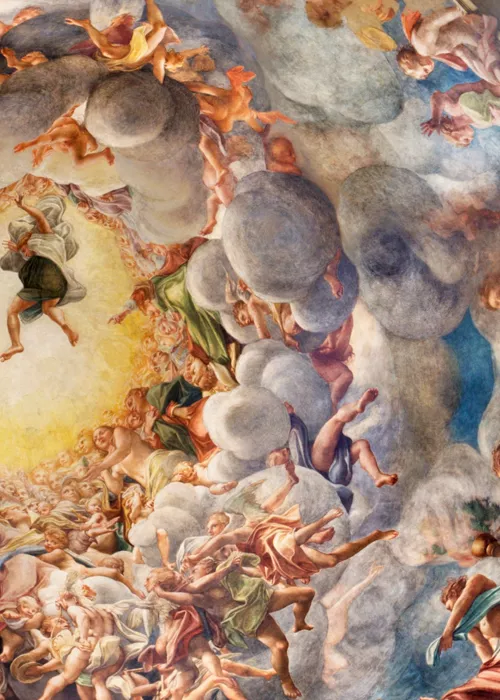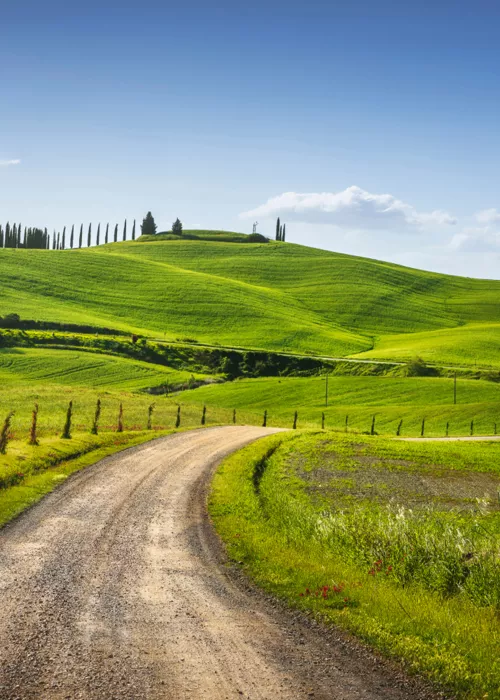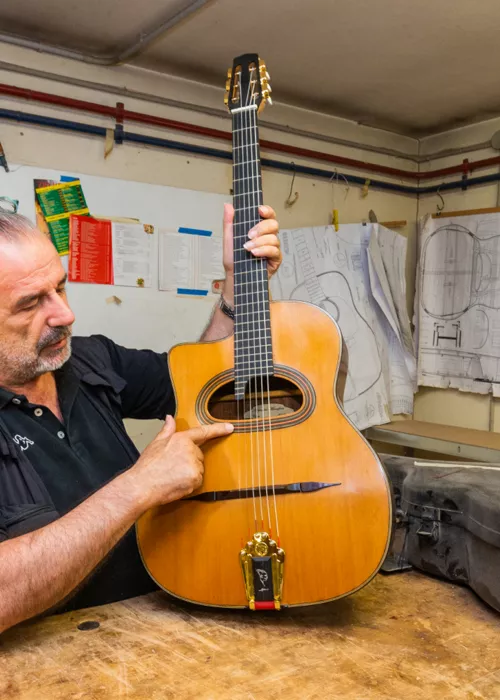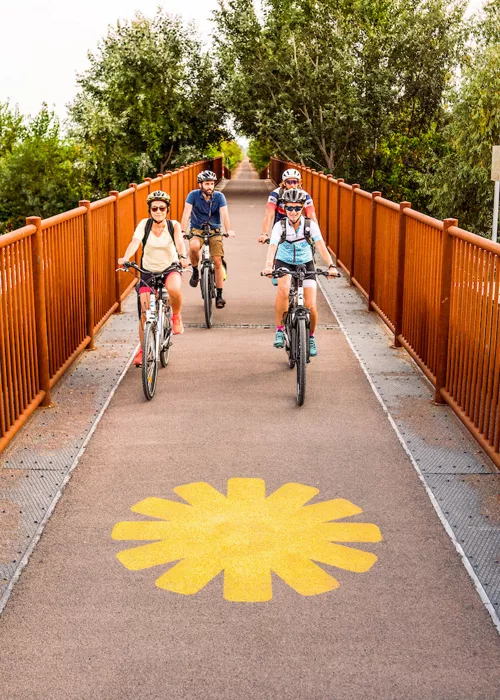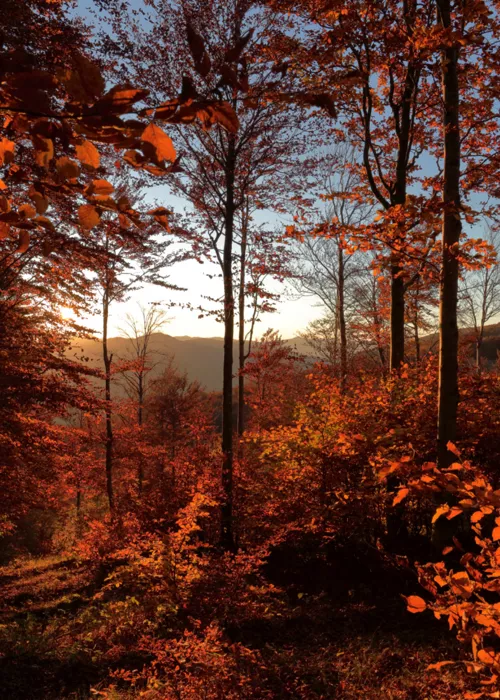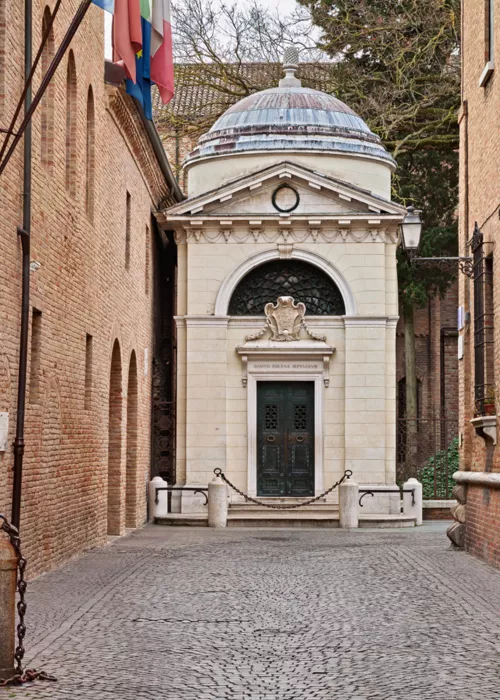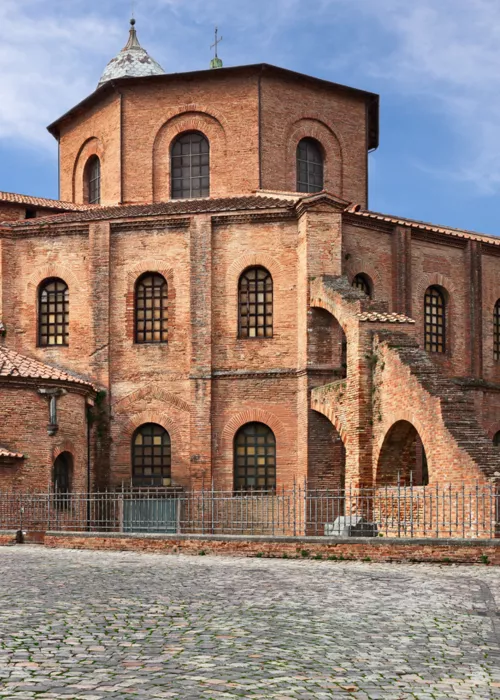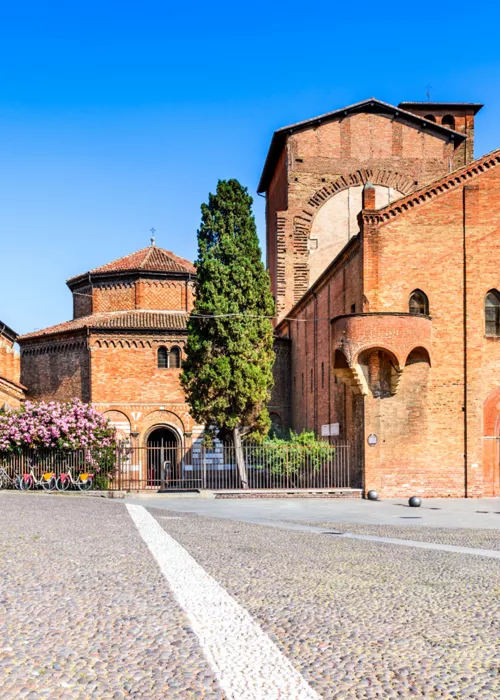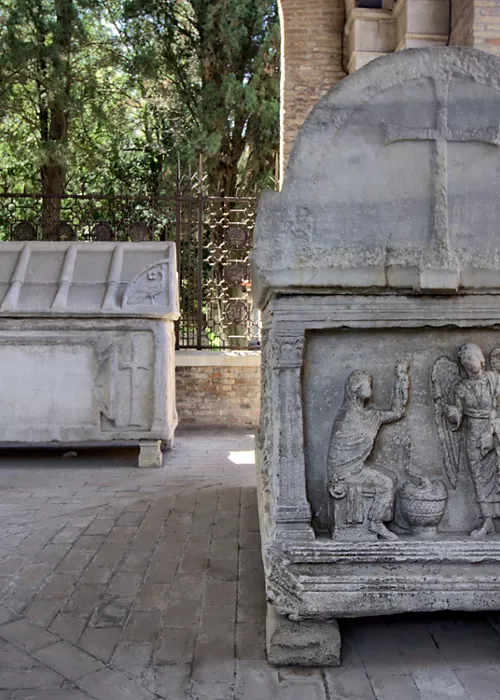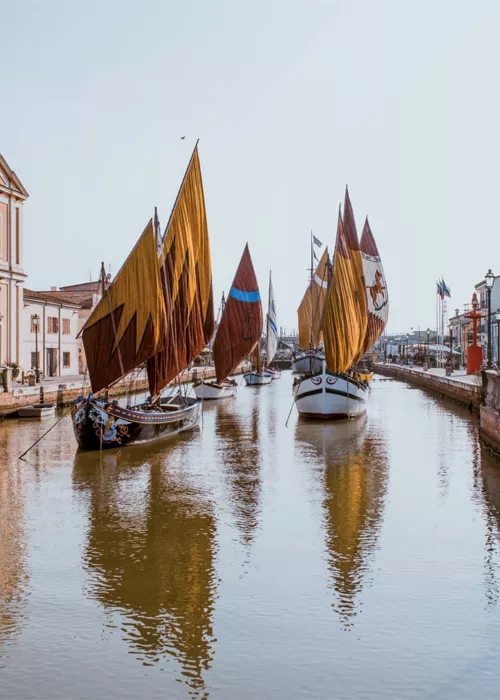Palazzo Farnese

As is known, the Farnese dynasty ruled the Duchy of Parma and Piacenza for centuries: acquiring a palace of adequate size here was part of its pride, and in particular of the ambitions of Margherita d'Austria, consort of Ottavio Farnese. The building is very impressive indeed, almost excessive compared to the rest of the city, even if it has a refined size. The Palace was built in the 1500s by expanding a previous Visconti City, built by the Visconti Dukes of Milan, a city whose influence is still felt on Piacenza. (To put it bluntly, there is no shortage of Interisti here, and the default regional news broadcasts on state television are from Lombardy).
If you look closely, you can see that the huge building is unfinished. The transfer of the capital of the duchy to Parma ended up weakening interest in the construction site, which was abandoned some forty years after work began. But if you contemplate the mass today, and especially if you visit the Civic Museums of the Palace, you will not be one bit disappointed.
Not far from Palazzo Farnese, you can continue in a historical-architectural vein by visiting the churches of S. Eufemia, which can be visited with a welcome invite from the volunteer members of the Italian Touring Club and S. Sisto.
Piazza dei Cavalli

Pope Alexander on the left – looking at the two equestrian statues in the background of the Gothic Palace – and his son Ranuccio on the right confirm to everyone that here they had long ruled the Farnese, a family originally from the area of Viterbo, imposed on the government of Piacenza by Pope Paul III in 1545.
In fact, the city belonged to the temporal power of the Church of Rome, and the pontiff Paul III was – who would have thought it – a Farnese in those years. The pair of horses that mark the Piazza recalls a domination that continued until almost the middle of the 18th century, although not all the people of Piacenza must have always agreed: the assassination of the first Duke Farnese almost immediately convinced the Farnese to move the capital of their new duchy to Parma.
That's the story to here, at least in very general terms, but the widening imposes itself above all by its size, by certain shops that begin to signal an elegance soon confirmed in the surrounding streets, by important buildings - opposite the Gothic Palace stands the Palazzo del Governatore, on the side the neo-Gothic façade of S. Francesco – and the undisputed central focus of the Piazza. Here, an urban section of Via Emilia and the road, which today is called Via XX Settembre, cross paths, leading straight to the Cathedral.
Gothic Palace

The historical newspaper of Piacenza – which often stands out with its header above the news-stands – is called La Libertà, and rightly so. It is undeniable that the main building in the central Piazza dei Cavalli is one of those mediaeval palaces that in many cities of northern Italy testify to the centuries-old origins of local freedoms. Elsewhere, these palaces are called Broletti or Palazzi della Ragione, that is, places where it was not some more or less imperial gentleman who "agreed", or administered justice, but the community of citizens.
The Gothic Palace, so called because of its prevailing architectural style, is in fact the historic Palazzo Comunale, originally built at the end of the 20th century and immediately equipped with a hall that would host the meetings of the representatives of the Piacenza area. In the courtyard there is a tower about forty metres high with a spiral staircase inside: a fourteenth-century chronicle reports that – almost as though to give a sanction of nature to the affirmation of self-government – "three hundred crows and heels appeared on the tower of the palace". On the other hand, a religious sanction seems to guarantee a Madonna and Child in a niche of the facade; to avoid weather damage, it was replaced by a copy (you can see the original in the Civic Museums of Palazzo Farnese.
Via Roma

From Piazza dei Cavalli you can be spontaneous and take Via XX Settembre, which is pedestrianised and quickly leads to the Cathedral amidst shops and clubs. But you can also choose the parallel Via Roma, a couple of blocks away along Via Cavour towards Palazzo Farnese, which corresponds to the ancient urban route of Via Emilia.
The street is a string of historic buildings. On the widening at the intersection with Via Giosuè Carducci, the church of San Pietro stands next to the portico of a late sixteenth-century building that was the Jesuit College. Like elsewhere at that time, at the end of the 18th century, the religious were also expelled in Piacenza from their headquarters, and the College became the Passerini-Landi Library. It is difficult to stop and enjoy it while walking around, but you can at least spare a thought for the fact that among the preserved manuscripts is the earliest version that has ever reached us of the Divine Comedy, year 1336.
In Via del Consiglio, a crossroads of Via Roma, to the left, the fifteenth-century Palazzo Landi has a beautiful marble portal in the shape of an arch of triumph. Further out along Via Roma, one encounters at number 80 the imposing Palazzo Costa in its rococo style, and at number 99 the Palazzo Anguissola di Grazzano, itself from the late 18th century, with baroque elements in the window frames. If, instead of taking Via del Consiglio to the left, you take Via Legnano to the right, you are less than two hundred metres from the Duomo.
Cathedral

Those who think that the great Romanesque cathedrals along the Via Emilia are in Parma and Modena forget to mention Piacenza, and are mistaken. It is true that in Piacenza it is only the façade, not the body of the church, that is immediately spectacularly exposed to view, and indeed the circumstance detracts somewhat from the theatricality of the whole. But this aspect is not enough to venture rankings, which are always questionable.
Perhaps the Cathedral of Santa Maria Assunta and Santa Giustina does not immediately impress, yet it attracts with its high sandstone and marble hut façade, and certainly fascinates inside. In addition to the architectural ensemble, the thickness and height of the pillars, it is the frescoes in the vaults of the central nave and the tiburium, also inside the dome, to be precise, that capture our attention.
The ceilings are distant and not really easy to see in detail: that's when the possibility of climbing up inside the dome to observe closely was organised. One hundred and thirty-six steps, but it's worth it. It is enough to know that you go up from the garden at Via Prevostura 7, behind the church, where you will find the Kronos - Cathedral Museum, which also offers multimedia. From 12:30 PM to 3:30 PM on Saturday, the visit is accompanied by the Volunteer members of the Italian Touring Club thanks to the Open for You initiative that favours the opening of places of art and culture usually closed to the public or limitedly accessible.
"Ricci Oddi" Gallery of Modern Art

Going from the Cathedral to the Ricci Oddi Gallery, following Via Chiapponi and then Via Scalabrini, you can pass from the square with the church of San Antonino, with its curious octagonal tower, and deviate for a moment to reach, on Via Giuseppe Verdi, the church of Santa Maria in Cortina, which can be visited on Saturdays in the early afternoon thanks to the Open for You initiative of the Italian Touring Club.
However, one arrives at Ricci Oddi shortly afterwards to view over two hundred works of painting, sculpture and graphics, mainly by Italian artists, assembled by Giuseppe Ricci Oddi from Piacenza and donated to the city in 1924. The representation of the Tuscan Macchiaioli is rich, including Giovanni Fattori, Telemaco Signorini and Silvestro Lega, but also works by Boldini, De Nittis, Pellizza da Volpedo, Medardo Rosso, Wildt, Hayez, Previati and Segantini. A Portrait of a Lady by Giovanni Boldini also stands out, and there are more recent works by Boccioni, Carrà, Campigli, Funi, De Pisis, Morandi, Casorati and Cassinari. The collections icon is still a Klimt.
The exhibition context is that of a former convent named after San Siro, converted for the purpose according to a design by local architect Giulio Ulisse Arata.
Basilica of St Mary of Campagna

If you go by car, you will find directions to S. Maria di Campagna while driving outside the ramparts of the Mura, not far from Porta Borghetto. On foot from Piazza dei Cavalli, the road is a little longer: say about twenty minutes to Via Roma, Via Mazzini, Via S. Tomaso and the name itself says Via Campagna. A bit like the Collegio Alberoni, which offers its eighteenth-century history and its Antonello da Messina practically at the opposite end of Piacenza along the Via Emilia Parmense, the Basilica is part of the major art venues peripheral to the city.
In architectural terms, S. Maria di Campagna is a sixteenth-century jewel, a masterpiece by Alessio Tramello from Piacenza, after whom the stretch of road outside Porta Borghetto is named. In artistic terms, it preserves an exceptional cycle of frescoes by Giovanni Antonio de Sacchis called il Pordenone. As far as religion is concerned, the church is a worthy host to the 'Madonna della Campagnola', a polychrome wooden image believed to be miraculous, while in terms of local history, it is known as a place much loved by the Farnese family, a ducal church where the dynasty celebrated baptisms and military victories. A plaque commemorates Isabella Farnese, buried here, and her brother Francesco.


